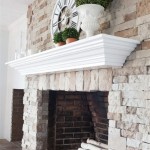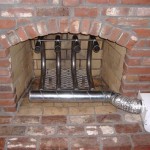Stacking Stone Fireplace: A Timeless Hearth
The stacking stone fireplace, a design element evoking both rustic charm and contemporary sophistication, represents a significant investment in home aesthetics and ambiance. Its enduring appeal stems from the inherent beauty of natural stone, coupled with the architectural impact of the stacked arrangement. This article delves into the various facets of stacking stone fireplaces, examining their benefits, design considerations, installation nuances, and maintenance requirements.
Aesthetic Advantages and Design Versatility
The primary allure of a stacking stone fireplace lies in its visual impact. The texture and color variations inherent in natural stone create a focal point that draws the eye and adds depth to a room. Unlike smooth, monolithic fireplace surrounds, the stacked arrangement presents a dynamic surface with subtle shadows and highlights that change with the lighting throughout the day. This inherent variability ensures that each stacking stone fireplace is unique, reflecting the natural character of the stone and the individual craftsmanship of the installer.
The design versatility of stacking stone fireplaces is another significant advantage. The choice of stone—ranging from traditional fieldstone and river rock to contemporary slate and quartzite—allows homeowners to tailor the fireplace to their specific design preferences. Furthermore, the size, shape, and color of the stone can be carefully selected to complement the existing architectural style and color palette of the room. A rustic cabin aesthetic might favor larger, irregularly shaped fieldstones, while a modern living space might benefit from the clean lines and muted tones of stacked slate.
Beyond the choice of stone, the stacking pattern itself offers further design flexibility. Stones can be arranged in a dry-stack pattern, creating a more rugged and natural appearance, or mortared together for a smoother, more refined look. The width of the mortar joints, the color of the mortar, and the overall layout of the stones can all be customized to achieve the desired visual effect. For example, a tight dry-stack arrangement with minimal spacing between the stones can create a contemporary and minimalist aesthetic, while a wider mortared joint with a contrasting mortar color can emphasize the individual character of each stone and add visual interest.
The integration of shelving, mantels, and other architectural details can further enhance the design of a stacking stone fireplace. A wooden mantel, crafted from reclaimed timber or a hardwood species, can provide a warm and inviting contrast to the cool, hard surface of the stone. Built-in shelving flanking the fireplace can provide storage and display space, seamlessly integrating the fireplace into the overall design of the room. The addition of lighting, such as recessed spotlights or sconces, can further enhance the visual impact of the stone and create a warm and inviting ambiance.
Installation Considerations and Technical Requirements
The installation of a stacking stone fireplace is a complex process that requires careful planning, skilled craftsmanship, and adherence to building codes and safety regulations. It is generally recommended to engage a qualified and experienced mason or fireplace installer to ensure a safe and aesthetically pleasing result. The installation process typically involves several key steps, including site preparation, structural reinforcement, stone selection and preparation, mortar application (if applicable), and finishing.
Site preparation is a critical first step, as it involves ensuring that the existing structure is capable of supporting the weight of the stone. Stacking stone fireplaces can be quite heavy, particularly when constructed with larger stones. In some cases, it may be necessary to reinforce the floor or foundation to accommodate the added weight. This typically involves consulting with a structural engineer to assess the load-bearing capacity of the existing structure and to design appropriate reinforcement measures.
The selection and preparation of the stone is another important consideration. The type of stone chosen will impact the overall aesthetic of the fireplace, as well as the ease of installation. Natural stone can vary significantly in size, shape, and thickness, which can make it challenging to create a uniform and aesthetically pleasing stacked arrangement. It is often necessary to sort and select the stones carefully, and to trim or shape them as needed to achieve the desired fit and appearance. The stone may also need to be cleaned and sealed to protect it from moisture and staining.
Mortar application, if applicable, is a crucial step in the installation process. The mortar serves to bind the stones together and to provide structural stability. The type of mortar used, the width of the mortar joints, and the application technique can all impact the appearance and durability of the fireplace. It is important to choose a mortar that is compatible with the type of stone being used and to apply it carefully to ensure a strong and weather-resistant bond. The mortar should also be properly cured to prevent cracking and crumbling.
Safety is paramount during the installation process. Proper ventilation is essential to prevent the buildup of harmful gases, such as carbon monoxide. The fireplace should be properly vented according to local building codes and regulations. The installation should also comply with fire safety standards to prevent the spread of fire. This may involve installing a fire-resistant hearth extension, using non-combustible materials in the construction of the fireplace surround, and ensuring that the chimney is properly lined and insulated.
Maintenance and Longevity
Once installed, a stacking stone fireplace requires regular maintenance to ensure its longevity and aesthetic appeal. The frequency and type of maintenance will depend on the type of stone used, the climate, and the frequency of use. Regular cleaning is essential to remove dust, dirt, and soot that can accumulate on the surface of the stone. This can be done with a soft brush, a vacuum cleaner with a brush attachment, or a damp cloth. Avoid using harsh chemicals or abrasive cleaners, as these can damage the stone.
Sealing the stone can help to protect it from moisture and staining. A high-quality stone sealer can penetrate the pores of the stone and create a water-resistant barrier. This can help to prevent water from seeping into the stone and causing damage, such as cracking or efflorescence (a white, powdery deposit that can form on the surface of the stone). The sealer should be reapplied periodically, according to the manufacturer's instructions.
Inspecting the mortar joints regularly is also important. Over time, the mortar can crack or crumble due to weathering and temperature fluctuations. If cracks are detected, they should be repaired promptly to prevent water from entering the fireplace structure and causing further damage. Mortar repairs can be done with a patching compound designed for stone and masonry.
Proper ventilation is crucial for the longevity of the fireplace. Ensure that the chimney is clean and free of obstructions to allow for proper airflow. Regular chimney sweeps are recommended to remove creosote buildup, which can be a fire hazard. Inspect the chimney cap and spark arrestor to ensure that they are in good condition and properly functioning. A well-maintained chimney will help to prevent smoke and fumes from backing up into the house and will extend the life of the fireplace.
Addressing potential issues promptly will contribute to the long-term preservation of a stacking stone fireplace. Any signs of water damage, such as dampness or staining, should be investigated and addressed immediately. Cracks in the stone or mortar should be repaired to prevent further damage. With proper care and maintenance, a stacking stone fireplace can provide years of warmth and beauty.

12 Stacked Stone Fireplace Ideas For Optimal Coziness
.jpg?strip=all)
Tips And Tools For Professional Stacked Stone Fireplaces

12 Stacked Stone Fireplace Ideas For Optimal Coziness

5 Stacked Stone Surrounds Travertine Quartzite Or Marble

Natural Stacked Stone Veneer Fireplace Ideas

Pin On Woodworking

Is A Cozy Stacked Stone Fireplace Your Next Dream Project

Contemporary Living Room Stacked Stone Fireplace Wooden Mantel Glass Coffee Table Modern Fireplaces Wall

Natural Stacked Stone Veneer Fireplace Ideas

Fireplaces Eldorado Stone
Related Posts








